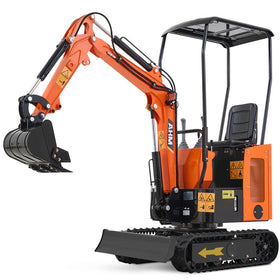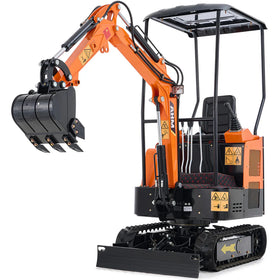Skid steer loaders have become indispensable on construction sites, offering versatility in earthmoving tasks such as digging, landscaping, and debris removal. The choice between wheeled skid steers and compact track loaders holds significant implications for project success. This blog explores the functionalities, differences, and considerations for selecting the best fit for your needs.
(Reading Time: 3-5 Minutes)

Understanding the Basics:
Skid steers and compact track loaders share similar functionalities, making them interchangeable in many scenarios. The primary distinction lies in the presence of wheels on skid steers and tracks on compact loaders. To make an informed decision, it's crucial to comprehend the tasks each excels at.
|
|
Skid Steer |
Compact Track Loader |
|
Terrain |
Suited for paved surfaces like asphalt and concrete |
Excels on uneven and soft terrain |
|
Speed |
Agile movement and quick turns in confined spaces |
Reduced speed with tracks, especially during turns |
|
Power |
Tailored for lighter loads, requiring less horsepower |
Additional weight and traction for handling heavier loads |
|
Maneuverability |
Capable of sharp turns and rotation in tight spaces |
Performs sharp turns but may need more room to maneuver |
|
Cost |
Lower costs for maintenance, fuel, transportation, and upfront |
Higher upfront cost, along with increased maintenance and fuel expenses |
|
Maintenance |
Economical and easier maintenance with wheels |
Challenging access to undercarriage complicates maintenance |
|
Site Cleanup |
Minimizes damage on hard surfaces but may disturb soil and softer ground |
Gentle on soil, sand, and gravel, but potential for marking asphalt and concrete |
Wheeled Skid Steer:

Image from bobcat
A wheeled skid steer, designed for digging and landscaping, operates on four wheels. Its two arms can connect to various attachments like buckets, snowblowers, and pallet forks. Steering involves adjusting the speed of wheels on one side, offering maneuverability for small-scale digging and landscaping projects.
Compact Track Loader:

Image from John Deere
In contrast, a compact track loader runs on parallel tracks, providing enhanced traction and stability. While resembling skid steers in size and functionality, their weight and traction make them more suitable for navigating slippery or uneven terrain. Ideal for earthmoving tasks requiring increased stability.
Main Differences Between Wheeled Skid Steers and Track loaders:
To aid in your decision-making process, let's delve into the critical distinctions between wheeled skid steers and compact track loaders across various factors.
Terrain:
- Skid Steer: Excels on hard, flat surfaces like concrete and asphalt, minimizing damage.
- Track Loader: Thrives on uneven and soft terrain, providing stability and preventing sinking in challenging conditions.
Speed:
- Skid Steer: Offers faster movement on flat surfaces, ideal for projects with sharp turns and crowded worksites.
- Track Loader: While not as fast, it compensates with stability, crucial for projects on unstable terrain.
Maneuverability:
- Skid Steer: Performs sharp turns and rotations in tight spaces, suitable for confined job sites.
- Track Loader: Offers comparable turning capabilities but may require more space due to larger size.
Power:
- Skid Steer: Designed for lighter loads with reduced traction, may face challenges with high-resistance materials.
- Track Loader: Even weight distribution with tracks provides higher lifting capacity and better performance with heavy loads.
Cost
- Skid Steer: Generally lower upfront and maintenance costs, fuel, and transportation expenses.
- Track Loader: Higher upfront costs, maintenance expenses, and potentially pricier track replacements.
Maintenance:
- Skid Steer: Easier maintenance with accessible parts and undercarriage, suitable for tight schedules.
- Track Loader: Requires more time for cleaning and maintenance, especially undercarriage care.
Site Cleanup:
Skid Steer: Gentler on hard surfaces but may cause disturbance on softer ground.
Track Loader: Minimizes damage on softer surfaces, offering efficient cleanup for landscaping projects.
Conclusion
Selecting the right loader – wheeled skid steer or compact track loader – hinges on your project's specific needs. Skid steers are ideal for smaller, fast-paced jobs on flat surfaces, emphasizing affordability and maneuverability. On the contrary, compact track loaders excel on uneven terrain, offering the power and stability necessary for more demanding projects. Consider your project's requirements carefully and consult with local or online equipment rental companies for tailored options and pricing.
FAQs: Skid Steer Loaders vs. Compact Track Loaders
1. What types of jobs are best suited for skid steer loaders?
Skid steer loaders are ideal for projects on firm, paved ground where speed and maneuverability are important, such as landscaping, debris removal, and site cleanup.
2. Are attachments interchangeable between skid steers and compact track loaders?
Many attachments—such as buckets, pallet forks, augers, and brooms—are compatible with both types of machines. However, always check the manufacturer’s guidelines to ensure compatibility and safe operation.
3. How do I choose between a skid steer and a compact track loader for my project?
Consider your typical job site conditions:
-
Choose a skid steer loader if you work mostly on hard, flat surfaces and need a cost-effective, agile machine.
-
Choose a compact track loader if you frequently operate on soft, muddy, or uneven terrain and require better traction and stability.
4. What safety tips should I follow when operating a skid steer loader?
-
Always use seat belts and safety bars.
-
Never exceed the rated operating capacity.
-
Keep loads low while moving.
-
Avoid sharp turns on slopes.
-
Ensure all safety features, like rollover protection and side screens, are in place.
5. Why should I consider AHM skid steer loaders?
AHM skid steer loaders are built for reliability, performance, and ease of maintenance. With a strong support network and a range of models to fit different needs, AHM offers solutions that help maximize productivity and minimize downtime.







